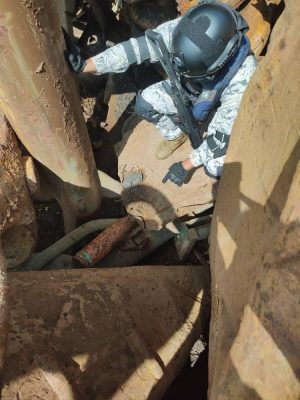Malaysia’s maritime agency said yesterday that it had found what it believes is a World War II-era artillery shell aboard a China-registered vessel detained on Sunday for anchoring in its waters without permission.
In a statement yesterday, First Admiral Nurul Hizam Zakaria of the Malaysian Maritime Enforcement Agency (MMEA) announced that the agency was investigating the ship in connection with the recent ransacking of two British shipwrecks.
For the past few weeks, the Malaysian press has reported that scavengers were pillaging two wrecked British warships off the coast of Pahang – the HMS Prince of Wales and HMS Repulse – which were sunk by Japanese submarines in December 1941, in the opening days of Japanese blitzkrieg on British Malaya and Singapore.
According to a May 20 report in the New Straits Times, fishermen and divers alerted the Malaysian authorities after spotting what they believed to be foreign grab dredger operating in the area last month. These foreign “treasure hunters” were targeting “the steel, high-grade aluminium and brass fixtures” aboard the British wrecks, the paper reported.
Zakaria announced that the Fuzhou-registered ship failed to present anchoring permits during a routine inspection in waters off Malaysia’s southern Johor state on Sunday. It said there were 32 crew members aboard, including 21 Chinese nationals, 10 from Bangladesh, and one Malaysian.
“We are studying the possibility that the vessel may have gone back and forth to a mothership to offload the stolen items,” Zakaria said. “This is a distinct possibility.”
According to the National Museum of the Royal Navy, 842 men died in the sinking of the HMS Prince of Wales and HMS Repulse on December 10, 1941, which it described as “one of the worst disasters in British naval history.” Deprived of superiority at sea, the British were subsequently routed on land. By the end of January 1942, Malaya had fallen to Japan’s armies; on February 15, Singapore surrendered, with much of the rest of Southeast Asia to follow.
Last week, responding to reports of illegal salvage activity, the museum’s director general, Professor Dominic Tweddle, said in a statement that he was “distressed and concerned at the apparent vandalism for personal profit” of the two shipwrecks. Both of which are designated war graves, and are protected under international maritime law.
The MMEA announced it believed the rusty cannon shell discovered on Sunday was linked to the police seizure on May 19 of piles of scrap metal and dozens of unexploded 135mm and 40mm artillery shells and scrap metal at a private scrapyard in Johor, which is believed to be from the HMS Prince of Wales. The MMEA said that it will work with officials from the National Heritage Department to identify the cannon shell.
For years, looters have plundered old shipwrecks in Malaysian and Indonesian waters, including sunken British and Dutch warships, seeking scraps of brass, copper, and what is known as “pre-war” or “low-background” steel. Produced prior to the detonation of the first nuclear bombs in the 1940s and 1950s, this steel is often sought out for use in the production of sensitive scientific equipment, including modern particle detectors, because postwar steel is generally contaminated with traces of nuclear fallout. Due to its growing scarcity, it can fetch very high prices on the open market.
According to the New Straits Times, the recent illegal salvage activity is the first that has been seen off the coast of Pahang since 2015, when several groups of foreign scavengers were discovered using home-made explosives to dislodge steel plates and fittings from old wrecks. These were subsequently brought to an end by regular patrols by the MMEA and Royal Malaysian Navy, the paper reported.

































